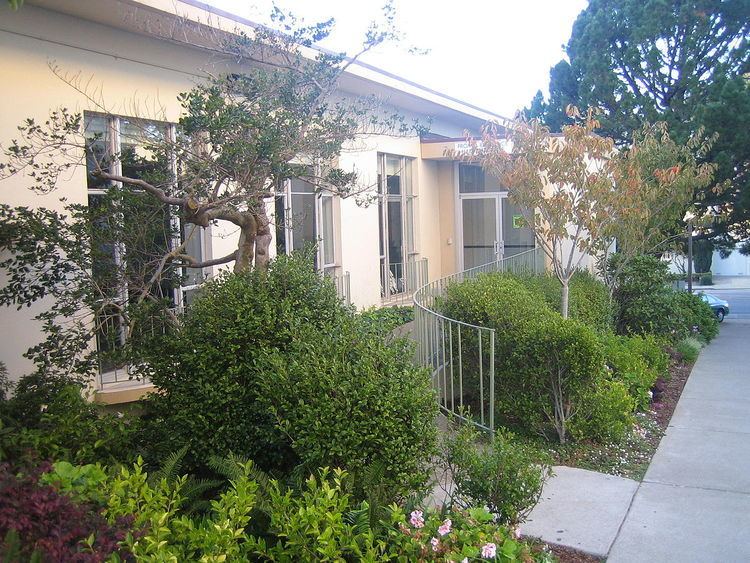 | ||
This section gives an overview of each of the residence halls at the University of San Francisco. It provides a description, photographs and history of both on campus residence halls for freshmen and sophomore students and independent living options for upperclassmen.
Contents
Residence Hall Amenities
Each residence hall, or dormitory contains at least one lounge, a kitchen, and laundry facilities. Halls are secured with a 24-hour desk staff. Community programs and activities are planned by Resident Advisors, Resident Ministers, Residence Hall Council, and Residence Hall Association.
Fromm Hall (FR)
Located next to Gleeson Library and St. Ignatius Church, Fromm Hall was formerly known as Xavier Hall, after Saint Francis Xavier. Fromm Hall was later renamed after university benefactors Alfred and Hanna Fromm on October 24, 2003. Fromm Hall is the University of San Francisco’s only all-female residence hall, providing housing for 175 freshmen and sophomore women.|Fromm is also home to Fromm Institute for Lifelong Learning, parish offices of St. Ignatius Church, XARTS (the fine arts program's facility, located in the building's old garage), and the Women's Initiative for Resources, Education, and Development (W.I.R.E.D.).
Gillson Hall (GI)
Gillson Hall, constructed in 1965, is a freshmen residence hall. Gillson is named after University benefactor George Gillson who provided funding for the hall. Gillson provides housing for 325 first year students and as a hall it is co-ed, alternating between men and women’s floors. The ground floor of Gillson Hall contains the offices of the Counseling and Psychological Services.
Hayes-Healy Hall (HH)
Adjacent to the baseball field on Main Campus, Hayes-Healy Hall is situated next to Memorial Gym, Ulrich Field, and Gillson Hall. Built in 1966, the hall was named by John Healy and Ramona Hayes-Healy in honor of their parents, Mr. and Mrs. Joseph Hayes and Mr. and Mrs. Richard Healy. Originally housing only women, it now is a co-ed residence hall for 350 first year students with men and women housed on alternating floors. Currently, The Martín-Baró Scholars is the only Living-Learning community housed in Hayes-Healy. The Martín-Baró Scholars focuses on social justice and diversity. Freshman students of The Garden Project, a Living-Learning Community which maintained the campus community garden and focused on sustainable living, also lived in Hayes-Healy until the fall semester of 2011 when The Garden Project was replaced with an Urban Agriculture minor. The building also recently began composting as a part of the composting pilot program in residence halls.
Lone Mountain (LMN)
During the 19th century the land now known as Lone Mountain was a 23-acre (93,000 m2) cemetery. In 1900 San Francisco city supervisors outlawed any more burials within the city limits. The land then housed Lone Mountain College, which was eventually purchased by the University of San Francisco. Lone Mountain is located one block north of the main campus. This co-ed hall houses 180 students, primarily sophomores and juniors who occupy both single and double dorms and double-room dorms. Lone Mountain houses the Global Living Community. The building also includes University offices of the University President and Vice-President, several classrooms, and Outtakes Quick Cuisine, which offers cafeteria-style food for residents and students.
Pedro Arrupe Hall (PA)
Originally a nurses' residence for the old French Hospital, USF acquired and renovated the building in 2000; however, because of the building's historical nature the rooms are all different layouts and are significantly smaller than the rooms of other residence halls. Named for Pedro Arrupe, S. J., former Superior General of the Society of Jesus, it is located 12 blocks west of campus. It houses just under 100 upper-division and graduate students. The facilities at this residence hall make it possible for students to live independently of the university by providing a kitchen, computers, a laundry room, and vending machines.[2]
Phelan Hall (PH)
Named after USF alumnus James D. Phelan, former U.S. Senator from California and mayor of San Francisco, Phelan hall is USF's oldest and largest residence hall. Initially housing 386 students, it now provides housing for 450 first and second year students. The centrally located building also houses the school radio stations, KDNZ (880 AM) and KUSF (defunct) (90.3 FM), the University bookstore, the San Francisco Foghorn, the Office of Residence Life, and the University Ministry Office.
Independent living/Upper-division housing
Upper-Division student housing at USF offers almost all the same amenities that come with living on-campus in an off-campus setting. These include access to kitchens, Resident Advisors, laundry machines, high-speed internet, telephones, and lounges.
Fulton House
Acquired by the University in the 1970s initially to house international students, Fulton house is located behind Phelan hall on the perimeter of campus. It consists of two separate buildings, providing a "home" living environment for 12 upper-division students. The large house accommodates nine students including one Resident Advisor. It has three double rooms, two single rooms, and 2 1⁄2 bathrooms, all of which are furnished. They share a full kitchen, a furnished living room and small dining room.
Fulton House Cottage
The smaller house, known as "the Cottage," is located adjacent to the larger house. It houses three residents who live in one double room and one single room. It includes a full bathroom, a kitchenette, and a furnished living room.
Loyola Village (LV)
Built in 2002, this condominium-style residential complex of 136 units houses faculty, staff, and students. This complex is located behind Lone Mountain, facing Anza street, on the edge of the USF campus. Most of the rooms in Loyola Village are double occupancy, but other apartments can vary in size from studio to 3-bedroom 3-bathroom floor plan. The village also includes "Town Houses" for graduate and non-traditional age undergraduate students.
Architecturally, this building was made with double padded walls to reduce sounds from unit to unit. It was also built with a garage so that its residents may have a parking facility for their cars for monthly fee.
